5 Emerging E-Procurement Trends to Follow


In the past few decades, the electronic handling of procurement processes—e-procurement—has enabled companies to transform their workflows, moving from paper to digital and then to the cloud.
Since then, further high-tech advancements have exponentially broadened the scope of what e-procurement solutions can do.
This has given rise to advanced systems that incorporate AI and machine learning, robotic process automation, blockchain technology, and predictive analytics.
In this article, we’ll explore these emerging e-procurement trends that every procurement team should follow to optimize efficiency, reduce costs, and drive innovation in their supply chains.
Not so long ago, when a company wanted to digitize its procurement processes, it had to purchase or build an on-premises software system.
Such systems required substantial hardware, ongoing maintenance, and specialized IT support, making them costly and complex to manage.
Then came the Internet, and companies had to invest in servers and IT infrastructure to enable their systems to function online, further increasing expenses.
Around that time, providers started offering companies the option to rent data storage and hosting services in the cloud.
This was soon followed by software providers offering businesses to consume their products via the Internet instead of on-premises software, giving rise to Software-as-a-Service (SaaS) and related cloud computing models, such as PaaS and IaaS.
Ultimately, this generated a substantial shift towards cloud-based solutions in all areas of business, including procurement.
Why?
Because of the benefits cloud solutions provide for companies and their procurement teams when compared to on-premises, legacy software systems.
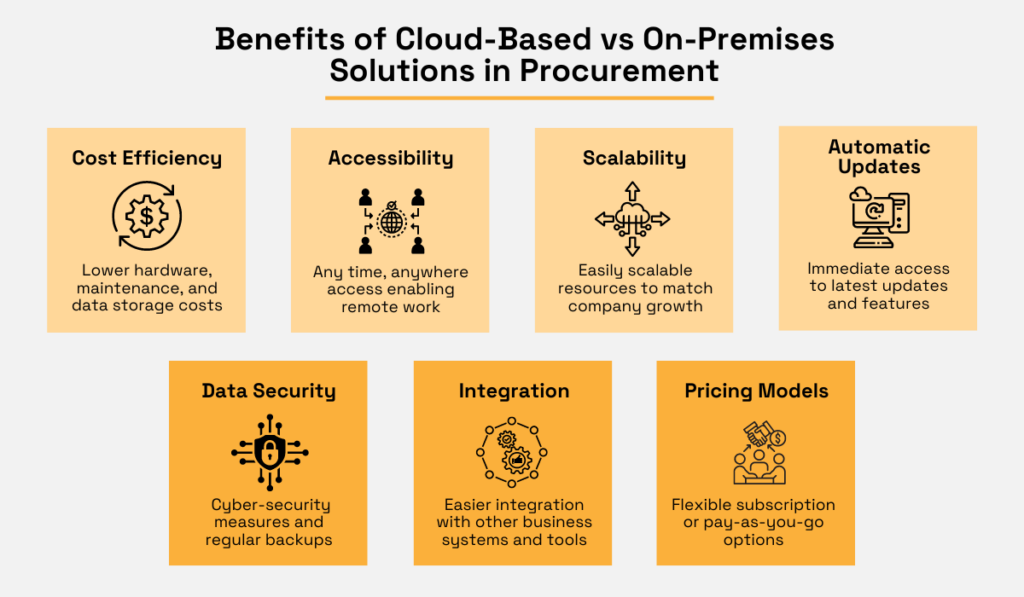
Source: Veridion
To illustrate some of these advantages, let’s start with cost-efficiency.
Cloud solutions eliminate the need for substantial upfront investments in hardware, physical servers, data centers, or extensive infrastructure.
They also reduce the ongoing costs associated with maintenance and IT support.
Additionally, cloud service providers handle regular updates and improvements, provide data security measures, and troubleshoot issues, further reducing the operational burden on in-house IT teams.
Flexible pricing models add another dimension to this cost-effectiveness.
As cloud-based procurement solutions are typically paid on a subscription or pay-as-you-go basis, this flexibility makes it easier for businesses to manage their budgets and scale their operations according to fluctuating business needs.
You can see an example of one such solution below.
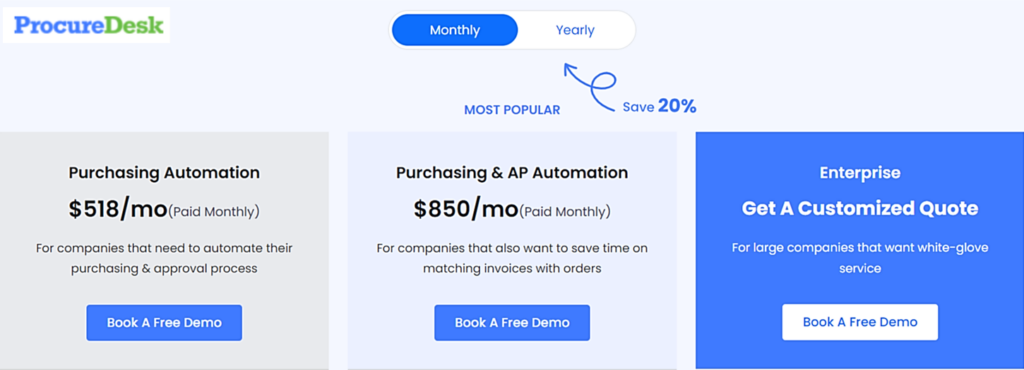
Source: ProcureDesk
Of course, one of the main benefits of cloud solutions is their accessibility.
In other words, cloud-based procurement software can typically be accessed on any Internet-connected device, enabling procurement team members to work remotely or across different locations.
Moreover, this enhances the ability of the procurement team and other stakeholders to access up-to-date data in real time, stay connected, and maintain productivity, regardless of geographical barriers.
Given all these advantages, it’s not surprising that a significant portion of companies have already moved their procurement applications and data fully into the cloud.
Others use a combination of cloud-based and on-premises solutions, whether due to legacy systems or to retain greater control over proprietary data.
This is supported by the 2023 APQC study, which analyzed benchmarking data from 1,181 companies worldwide.
The study found that 31% of companies use entirely cloud-based procurement applications and data storage, 48% use a cloud/on-premises combination, and only 21% are fully on-premises.
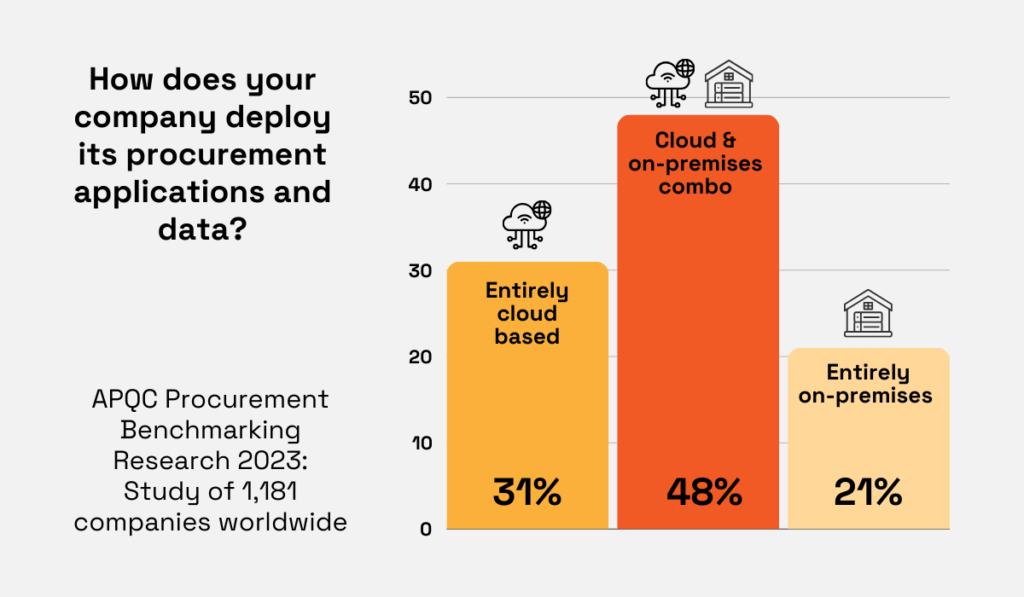
Illustration: Veridion / Data: SDC Executive
These numbers show that the shift toward cloud-based solutions in the procurement sector is well underway.
Lastly, it should be underlined that all the other e-procurement trends outlined in this article would not be possible or would be greatly limited without relying on cloud solutions.
Simply put, traditional on-premises software systems are rarely capable of efficiently storing, processing, and analyzing large and diverse sets of procurement data coming from numerous internal and external sources.
Conversely, various cloud-based solutions powered by AI and machine learning can provide procurement teams with significantly enhanced data analytics capabilities, leading to real-time insights and data-driven, informed decision-making.
This brings us to our next trend.
Despite being all the hype right now, artificial intelligence (AI) and its subset, machine learning (ML) algorithms and models, have been around for a while, and so has their use in procurement.
As we’ll cover in the next section, these algorithms initially relied on predefined rules and patterns to process data and were used for routine process automation, such as purchase order processing and invoice matching.
Then came more advanced, deep learning (DL) models.
They were designed to learn from large datasets and improve their performance over time.
This evolution enabled procurement teams to automate even more complex tasks, analyze vast amounts of data quickly, and derive actionable insights.
Ultimately, these and other AI techniques created a rich landscape of software solutions, application suites, and platforms that can be used to streamline procurement processes.
As illustrated below, AI-powered platforms allow companies to digitize and automate numerous procurement tasks, from spend categorization and analysis to supplier sourcing, contract negotiation, and risk monitoring.

Source: Coupa
Faced with such a diversity of AI-assisted procurement workflows, let’s use just one process—supplier discovery—to illustrate how AI helps streamline it.
As you know, identifying potential suppliers that fit specific procurement criteria can be time-consuming and limited in scope.
However, both the speed and scope of this process can be greatly enhanced—by 90% or more, according to McKinsey—with the help of AI-powered machine learning models.
These data acquisition algorithms scour the Internet to capture the latest data, categorize it, and structure it to make it easily searchable and fit for analysis.
In other words, such big data solutions give procurement teams access to a vast, regularly updated, global database of suppliers with advanced search functions, enabling them to quickly discover the best potential candidates for their specific needs.
One such solution with the best-in-class, proprietary data acquisition models is our supplier sourcing tool, Veridion.
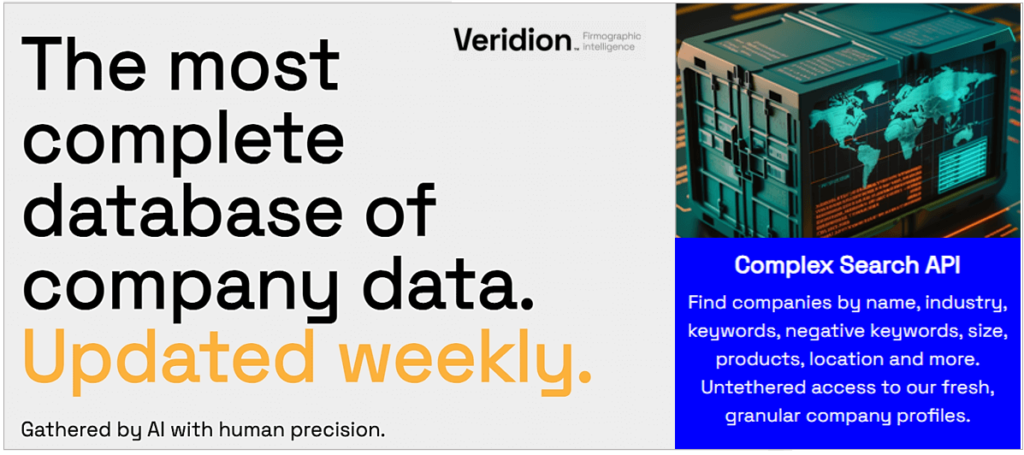
Source: Veridion
With Veridion, you get access to a weekly updated, AI-curated global database with over 80 million companies offering more than 290 million products and 110 million services.
Using our Complex Search API, your team can use natural language input to define their search parameters, i.e., procurement criteria.

Source: Veridion
That way, your procurement team can generate a shortlist of suitable suppliers in mere minutes.
Moreover, Veridion’s real-time data and analytics tools also enable your team to:
While this example nicely illustrates the power of AI and ML integration into procurement processes, it only scratches the surface of their versatile applications.
Lastly, this already growing trend of leveraging AI functionalities in business solutions exploded when generative AI entered the scene with the launch of ChatGPT and other similar tools soon after.
Based on large language models (LLMs), these tools can engage in human-like communication, create text, images, and other content, and complete tasks that previously required human intelligence.
For example, some companies like Walmart are using GenAI chatbots to negotiate simpler contacts with suppliers.
However, although great things are expected in the future, practical applications of GenAI in procurement are still limited, while traditional AI has already demonstrated its effectiveness in both data analytics and process automation.
As technology progressed, so did procurement software solutions.
They evolved from providing simple software automation to more advanced, AI/ML-enabled, robotic process automation (RPA) that can handle increasingly complex tasks.
Today, it’s difficult to draw a clear line between traditional and robotic process automation solutions, particularly as software providers are continuously updating their products and introducing new features.
In essence, it all boils down to how well they automate repetitive manual tasks in procurement, such as data entry, order processing, and invoice matching.
Here are just some examples of time-consuming, data-intensive procurement processes that can be effectively automated with the help of RPA.
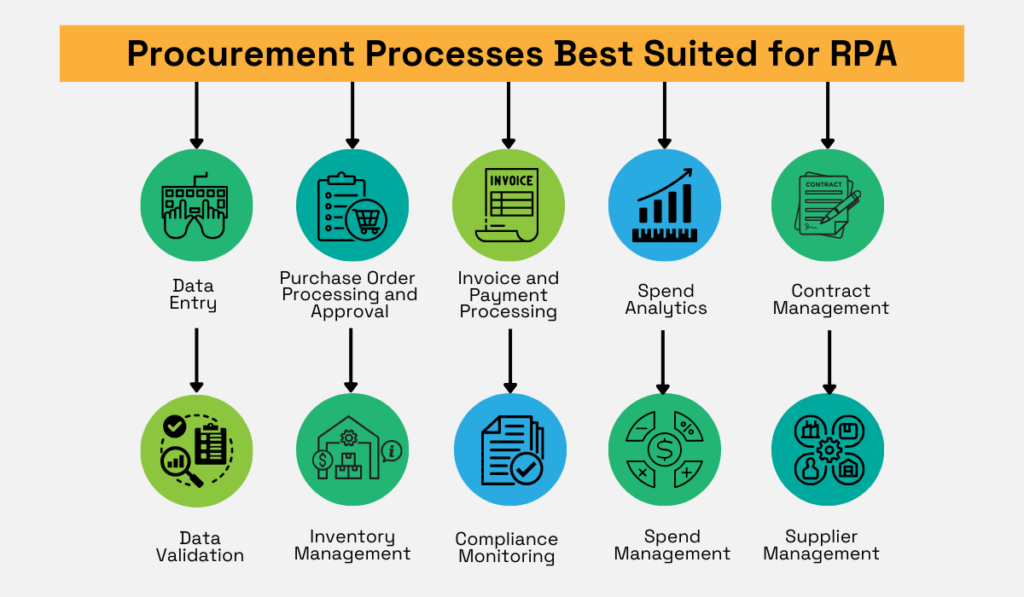
Source: Veridion
Let’s start with manual data entry.
With RPA, many data entry tasks can be automated, ensuring that information from various sources such as invoices, purchase orders, and supplier details is accurately captured and recorded.
This not only minimizes the time spent by staff on manual data entry and verification but also reduces the risk of human error.
To achieve this, RPA procurement solutions can use various features and technologies, such as:
This is what such a supplier portal can look like in practice:
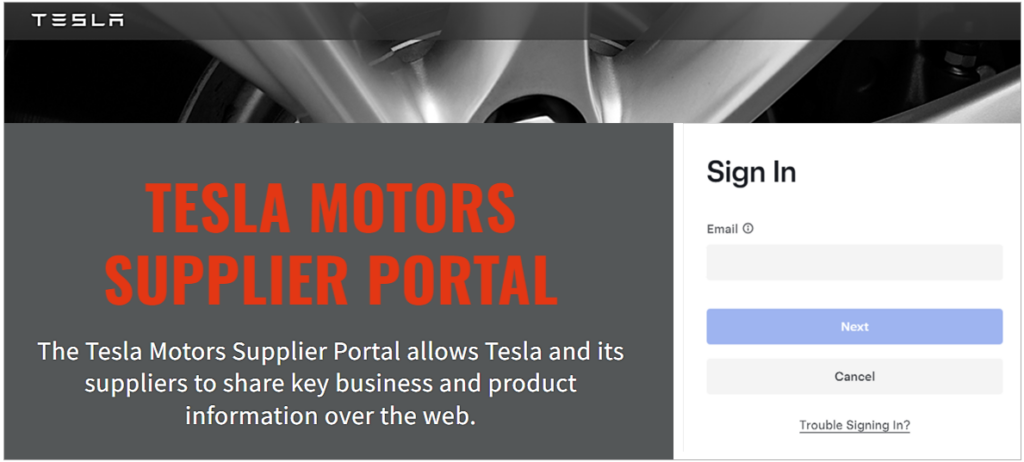
Source: Tesla
Along with automated data entry, RPA solutions can also streamline procurement data validation and cleansing to ensure accuracy and consistency.
Purchase order and approval processing is another area where RPA can make a significant impact.
More precisely, automating the creation, validation, and routing of purchase orders for approval can drastically reduce the time required to complete these tasks.
The same applies to invoice and payment processing.
This is where RPA can automate the extraction of data from invoices, match it with purchase orders, and initiate payment processes.
Next, automated inventory tracking, order placement, and management of inventory levels based on predefined thresholds ensure that procurement teams can maintain optimal stock levels and avoid stockouts.
Naturally, there are plenty more examples of how advanced, AI-driven process automation can save time, reduce errors, and improve efficiency, indicating that this e-procurement trend will only continue to accelerate.
Another emerging e-procurement trend is the adoption of blockchain technology in supply chain management processes.
This innovative technology creates a distributed ledger that records every transaction within a business network, allowing multiple participants to oversee it simultaneously.
Once a transaction is recorded, it becomes immutable and cannot be altered or deleted, creating a tamper-proof record.
That’s why, according to IBM:
“Blockchain is sometimes called a “trustless” network—not because business partners don’t trust each other, but because they don’t have to.”
In procurement, blockchain offers a reliable means of monitoring the journey of a product (raw material, component, etc.) or transaction from its origin to its acquisition and eventual payment.
For example, if you were a coffee producer sourcing raw coffee, you could join Farmer Connect, whose blockchain-based traceability solutions can help you ensure supply chain transparency and sustainability.

Source: Coffee Talk
At the start of coffee’s journey, Farmer Connect empowers farmers with their own digital identity and record of financial transactions, allowing them to connect to the agriculture supply chain and upload critical data to the blockchain.
Then, raw coffee is tracked via blockchain from the farmer, through the processor and shipper to the roaster (i.e., coffee producer), and ultimately to the final consumer.
That way, complete procurement traceability and transparency are ensured.
Overall, blockchain technology provides a secure and immutable method for tracking products and transactions, enhancing regulatory compliance, and fostering trust among all parties involved, including consumers.
This makes blockchain a powerful tool in the ongoing effort to improve procurement efficiency and meet consumer demand for transparency and sustainability.
Predictive analytics is a broad term used to describe a set of advanced analytical techniques that leverage historical data, statistical algorithms, and machine learning models to forecast future outcomes based on past trends and patterns.
Therefore, implementing predictive analytics in procurement typically does not involve adopting a single software solution.
Rather, it’s a combination of investing in data analytics, process automation, and AI tools, providing appropriate employee training, and finding the right data partners.
As such, predictive analytics can be used in a wide range of procurement use cases, starting with accurately forecasting product demand to streamline procurement planning, optimize inventory levels, and improve decision-making.

Source: Forbes
Another important use case is price forecasting.
This is where market intelligence and predictive analytics can be used to anticipate price fluctuations in raw materials and components, enabling companies to make informed purchasing decisions.
Similarly, predictive analytics can help monitor supplier risk and prevent supply chain disruptions due to, for instance, a supplier’s financial or regulatory problems, own sourcing issues, or local/regional political events.
More precisely, by automating risk monitoring and receiving real-time alerts, procurement teams can anticipate issues and make proactive decisions.
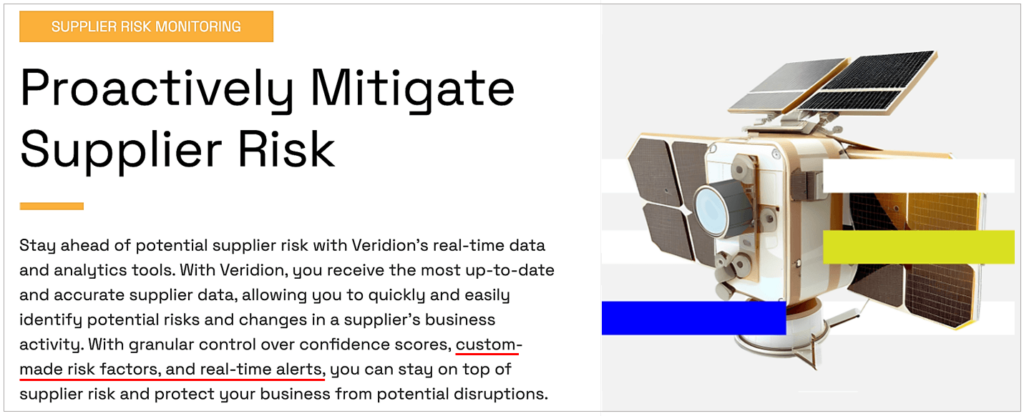
Source: Veridion
Likewise, monitoring and predicting market trends can inform a company’s strategic sourcing decisions.
Think, for instance, selecting innovative suppliers or shifting sourcing operations to take advantage of emerging markets with better supply stability.
Again, as with AI and process automation, it’s hard to cover all procurement cases for predictive analytics as they’re still evolving.
Suffice it to say, predictive analytics are among the top priorities of chief procurement officers, with the Hackett Group’s survey showing that 75% of them have a data analytics improvement initiative planned in 2024.
As we’ve shown in this article, leveraging cloud-based solutions integrated with AI, RPA, blockchain, and predictive analytics is revolutionizing procurement, and enhancing productivity, transparency, and strategic decision-making.
These technologies are not just trends, though.
They are essential advancements that empower procurement teams to operate more effectively and adapt to the evolving business landscape.
Embracing these e-procurement solutions sets companies up to achieve greater supply chain resilience, operational efficiency, and business competitiveness.